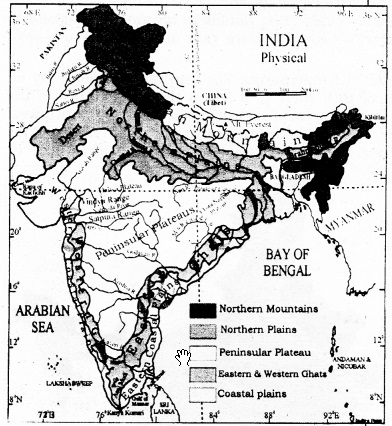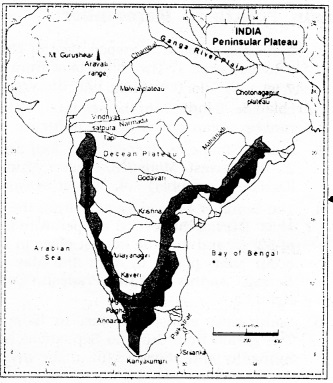Students can Download Geography Chapter 2 Indian Physiography Questions and Answers, Notes Pdf, KSEEB SSLC Class 10 Social Science Solutions helps you to revise the complete Karnataka State Board Syllabus and score more marks in your examinations.
Karnataka State Syllabus Class 10 Social Science Geography Chapter 2 Indian Physiography
Class 10 Social Science Indian Physiography Textual Questions and Answers
I. Fill in the blanks with suitable answers.
Question 1.
The Greater Himalayas are also known as ………….
Answer:
Himadri.
Question 2.
The lesser Himalaya are also known as ……………..
Answer:
Himachal.
![]()
Question 3.
In south India ………….. is the heighest peak.
Answer:
Anamudi.
Question 4.
The Eastern Ghats meet the Western Ghats in the ………… hills.
Answer:
Niligiri.
Question 5.
The Northern Great plain is made up of …………. soil.
Answer:
alluvial.
II. Discuss in groups and answer the following questions.
Question 1.
Which are the main physiographic divisions of India?
Answer:
On the basis of physiography India can be divided into four divisions. They are:
- Northern mountains.
- The Northern Great plains.
- The Peninsular Plateau.
- The coastal plains and Islands.
Question 2.
State how the Northern Great Plains were formed?
Answer:
The Northern Great Plains are in between the Himalayas and the Peninsular Plateau of India. It is formed by the depositional work of three river systems namely the Sutluj, the Ganga and the Brahmaputra. It is the largest alluvial soil tract in the world, extending east to west – a length of 2500 kms. Its average width varies from 240 to 340 kms. It covers an area of about 7 lakh km2. The plain is very flat and the rocks are not exposed on the surface.
Question 3.
Write briefly about the Siwalik hills.
Answer:
The Siwalik Hills are the outermost ranges or foothills located to the south of the main Himalayas. They are the lowest range of the Himalayas, with a height of 600 to 1500mts and width varying from 15-150 km. They extend from Jammu and Kashmir in the west to Arunachal Pradesh in the east. They have flat-bottom, structured valleys, which are known as ‘Doons’. eg: Dehradoon.
The Himalayas act as natural frontiers and prevent foreign invasion, they prevent the cold winds from central Asia. They obstruct the rain-bearing winds and this causes heavy rainfall. They are a storehouse of minerals and the birthplace of many rivers and waterfalls.
![]()
Question 4.
Distinguish between the Eastern Ghats and the Western Ghats.
Answer:
| Eastern Ghats | Western Ghats |
| i) The Eastern Ghats run almost parallel to the east coast of India. They extend from the Mahanadi Valley in the north, towards the Niligiri hills in the south where they join the Western Ghats. | These are a continuous range running parallel to the west coast of India from the Tapi valley to Kanyakumari. |
| ii) They are lower than the Western Ghats | They are very steep on the western side and gentle on the eastern side. |
Question 5.
State the importance of the Northern mountains.
Answer:
- The Himalayas act as natural frontiers and prevent foreign invasion, they prevent the cold winds from central Asia.
- They obstruct the rain-bearing winds and this causes heavy rainfall.
- Their slopes have thick forests and are ideal for plantation crops.
Eg: Tea in Assam They are a storehouse of minerals and the birthplace of many rivers and waterfalls which are used to generate hydro-electric power.
III. Activities:
Question 1.
Draw the outline map of India and show the major physical divisions of India.
Answer:

Question 2.
Draw the outline map of india and mark the important hill stations.
Answer:

Class 10 Social Science Indian Physiography Additional Questions and Answers
Question 1.
Nepales called Mt. Everest as …………
Answer:
Sagarmatha.
Question 2.
Himalaya mountain are …………..
Answer:
Natural.
Question 3.
The Northern Great Plain covers an area of about ……………
Answer:
7 Lakhs km2.
![]()
Question 4.
The Penninsular Plateau was being a part of the …………….
Answer:
Gondwanaland.
Question 5.
The western coastal plain lies between the ………… and ……………
Answer:
Western ghats, Arabian sea.
Question 6.
……….. is a hill station in the lesser Himalayas.
Answer:
Shimla.
Question 7.
………….. is the highest peak on the Abu hills.
Answer:
Guru Shikhar.
Question 8.
The Konkan coast lies to them …………
Answer:
South of Gujarat.
Question 9.
India has ………… islands.
Answer:
247.
![]()
Question 10.
The Lakshadweep islands are formed by …………
Answer:
corals.
Two Marks Questions
Question 1.
Name the Himalayas three parallel ranges
Answer:
- Greater Himalayas
- Lesser Himalayas
- Siwalik hills
Question 3.
Mention the parallel ranges in the lesser Himalayas.
Answer:
- The Pirpanjal
- The Dhaula Dhar
- The Naga Tiba
- The Mussorie
- The Mahabharat
- The Darjeeling ranges
Question 5.
How peninsular plateau has économical importance
Answer:
- The peninsular plateau is rich in minerals thick forests and biodiversity,
- It has an influence on southwest monsoons and it is covered with black soil which is useful or agriculture.
- The western ghats are the birthplace of many South Indian rivers, which are useful for the generation of hydroelectricity.
Question 7.
Write a note on the island of India.
Answer:
- There are about 247 islands in India of these 204 are in Bay of Bengal and 43 are in the Arabian sea. The Andaman and Nicobar islands are in the Bay of Bengal.
- The Lakshadweep islands are in the Arabian sea and are formed by corals.
We hope the KSEEB SSLC Class 10 Geography Solutions Chapter 2 Indian Physiography help you. If you have any query regarding Karnataka SSLC Class 10 Geography Solutions Chapter 2 Indian Physiography and Extension, drop a comment below and we will get back to you at the earliest.